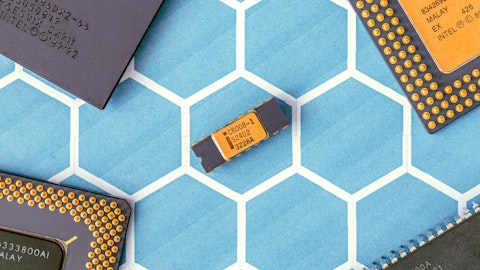Scott Bibaud: Yes. So I think in the past, when we’ve talked about our JDA customer, we talked about how we were working with the central engineering organization. They were evaluating our technology and then would recommend it out to the different business units. And obviously, over the last few years, we’ve gone from very general test requirements that they had to prove that our film was the type of quality that you take to production, down to more and more specific application solutions to problems they’re facing. The one that we’ve been working on over the past several months is a very challenging problem that their biggest business unit has been facing, and we believe we’ve delivered something really compelling to them.
Now, in our — in — we had created a JDA in the past, and we have set — put in place all the business terms for the JDA, but still haven’t gotten to the business terms about being able to do a full license that would take them to production. And we’re trying to work with them right now to figure out how can we find something that works for both them and us so that we could get a contract they’d feel comfortable and we’d feel comfortable, and then start working to implement this in the business unit.
Richard Shannon: Okay. So this sounds like a business-related dynamic with the JDA 1 customer, not anything technological in nature then. Is that fair?
Scott Bibaud: Yes. Right now, I would say that’s where we are. We’re on business. When we get done with the business and we start doing more detailed technical work, of course, we’ll be back into the technical side. But right now, I think we’re improving what we need to get to real solid business discussions.
Richard Shannon: Okay. Fair enough. Sounds like some good progress there. Let’s jump over to another question here. I think we’ve — since you announced STMicro, I think about 6 months ago, we’ve continued to ask a question about the halo effect that they may have on another analog peers. I mean one of your comments here, I think, you said that MSTcad was adopted by a large analog and power manufacturer, if you think is a first step to license technology. A, would you believe — do you see this as the STMicro halo effect having some impact on this particular customer? And what does this mean about entering into one of the phases in your status that you talk about every quarter?
Scott Bibaud: Yes. Okay. So first of all, we are out talking to customers all the time about MST SP and SPX, which are technologies we’ve developed ourselves using MST. And they show really impressive results. That should be enough for a customer to decide to use them. But the fact that we can say, we’ve also done a license agreement with ST, really, we think, helps to push it over the kind of over the top. Now what impact does that have on our customer pipeline that we showed you? Yes, the fact is that the — we can be working with customers in Phase 1 with MSTcad. We also can be working with customers in Phase 2 or Phase 3. Obviously, we think as MSTcad is going to be something that people use from the beginning until when they get into volume production.
For this particular customer, actually, we had been working with them on some other technology, and they’re already in Phase 3. So like I said, we believe we’ve made really good progress with them this quarter, but you can’t really see it by looking at our pipeline chart.
Richard Shannon: Okay. I know that doesn’t always capture that dynamic, but thanks for that detail, Scott. I know you discussed this and there was an interesting line in your press release this morning about the benefits of MST in both DRAM and advanced nodes. And maybe I’ll allow you to answer the question, either or both in aggregate, if you think that’s appropriate. But becoming increasingly clear to the industry, maybe you can give us some sense here. It seems like you’re getting some recognition in industry conferences or recognition from the white papers or whatever you’re writing. What makes you say this is become increasingly clear to the industry?


